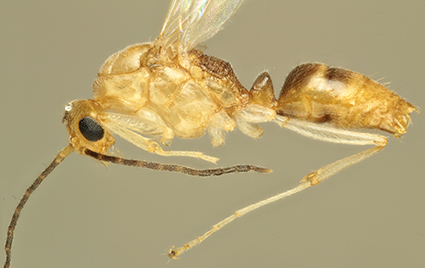References
Bednar, D.M. & Silverman, J. (2011) Use of termites, Reticulitermes virginicus, as a springboard in the invasive success of a predatory ant, Pachycondyla (=Brachyponera) chinensis. Insectes Sociaux, 58, 459–467. https://doi.org/10.1007/s00040-011-0163-0
Bertelsmeier, C., Guénard, B. & Courchamp, F. (2013) Climate change may boost the invasion of the Asian needle ant. PLoS One, 8 (10), e75438. https://doi.org/10.1371/journal.pone.0075438
Blatrix, R., Aubert, C., Decaens, T., Berquier, C., Andrei-Ruiz, M.C. & Galkowski, C. (2020) Contribution of a DNA barcode to an assessment of the specificity of ant taxa (Hymenoptera: Formicidae) on Corsica. European Journal of Entomology, 117, 420–429. https://doi.org/10.14411/eje.2020.046
Bolton, B. (2022) An online catalog of the ants of the world. Available from: https://antcat.org (accessed 20 February 2022)
Brown, W. L. Jr. (1958) A review of the ants of New Zealand. Acta Hymenopterologica, 1, 1–50.
Clement, M., Snell, Q., Walker, P., Posada, D. & Crandall, K. (2002) TCS: estimating gene genealogies. In: Parallel and Distributed Processing Symposium, International. IEEE Computer Society, Los Alamitos, California, pp. 1–184.
deWaard, J.R., Ivanova, N.V., Hajibabaei, M. & Hebert, P.D.N. (2008) Assembling DNA barcodes. In: Cristofre, M. (Eds.), Methods in molecular biology: environmental genetics. Humana Press, Totowa, New Jersey, pp. 275–294.
Eyer, P., Matsuura, K., Vargo, E.L., Kobayashi, K., Yashiro, T., Suehiro, W., Himuro, C., Yokoi, T., Guénard, B., Dunn, R.R. & Tsuji, K. (2018) Inbreeding tolerance as a pre-adapted trait for invasion success in the invasive ant Brachyponera chinensis. Molecular Ecology, 27, mec.14910. https://doi.org/10.1111/mec.14910
Forel, A. (1900) Fourmis du Japon. Nids en toile. Strongylognathus Huberi et voisins. Fourmilière triple. Cyphomyrmex wheeleri. Fourmis importées. Mitteilungen der Schweizerischen Entomologischen Gesellschaft, 10, 267–287.
Gotoh, A. & Ito, F. (2008) Seasonal cycle of colony structure in the Ponerine ant Pachycondyla chinensis in western Japan (Hymenoptera, Formicidae). Insectes Sociaux, 55, 98–104. https://doi.org/10.1007/s00040-007-0977-y
Guénard, B. & Dunn, R.R. (2010) A New (Old), Invasive Ant in the Hardwood Forests of Eastern North America and Its Potentially Widespread Impacts. In: Traveset, A. (Ed.), PLoS ONE, 5, e11614. https://doi.org/10.1371/journal.pone.0011614
Guénard, B., Wetterer, J.K. & MacGown, J.A. (2018) Global and temporal spread of a taxonomically challenging invasive ant, Brachyponera chinensis (Hymenoptera: Formicidae). Florida Entomologist, 101, 649–656. https://doi.org/10.1653/024.101.0402
Wong, M.K.L., Economo, E.P. & Guénard, B. (2021) The global spread and invasion capacities of alien ants. bioRxiv, 2021.11.19.469299. [published online] https://doi.org/10.1101/2021.11.19.469299
Mori, E., Magoga, G., Panella, M., Montagna, M., Winsor, L., Justine, J.-L., Menchetti, M., Schifani, E., Melone, B. & Mazza, G. (2021) Discovering the Pandora’s box: the invasion of alien flatworms in Italy. Biological Invasions, 24, 205–216. https://doi.org/10.1007/s10530-021-02638-w
Múrias dos Santos, A., Cabezas, M.P., Tavares, A.I., Xavier, R. & Branco, M. (2016) tcsBU: a tool to extend TCS network layout and visualization. Bioinformatics, 32, 627–628. https://doi.org/10.1093/bioinformatics/btv636
Nelder, M.P., Paysen, E.S., Zungoli, P.A. & Benson, E.P. (2006) Emergence of the Introduced Ant Pachycondyla chinensis (Formicidae: Ponerinae) as a Public Health Threat in the Southeastern United States. Journal of Medical Entomology, 43, 1094–1098. https://doi.org/10.1093/jmedent/43.5.1094
Park, S., Noh, P. & Kang, J.-Y. (2020) Endosymbionts and Phage WO Infections in Korean ant Species (Hymenoptera: Formicidae). Proceedings of NIE, 1, 52–57. https://doi.org/10.22920/PNIE.2020.1.1.52
Pyšek, P., Hulme, P.E., Simberloff, D., Bacher, S., Blackburn, T.M., Carlton, J.T., Dawson, W., Essl, F., Foxcroft, L.C., Genovesi, P., Jeschke, J.M., Kühn, I., Liebhold, A.M., Mandrak, N.E., Meyerson, L.A., Pauchard, A., Pergl, J., Roy, H.E., Seebens, H., Kleunen, M., Vilà, M., Wingfield, M.J. & Richardson, D.M. (2020) Scientists’ warning on invasive alien species. Biological Reviews, 95, 1511–1534. https://doi.org/10.1111/brv.12627
Rodriguez-Cabal, M.A., Stuble, K.L., Guénard, B., Dunn, R.R. & Sanders, N.J. (2012) Disruption of ant-seed dispersal mutualisms by the invasive Asian needle ant (Pachycondyla chinensis). Biological Invasions, 14, 557–565. https://doi.org/10.1007/s10530-011-0097-5
Schifani, E. (2019) Exotic ants (Hymenoptera, Formicidae) invading mediterranean Europe: a brief summary over about 200 years of documented introductions. Sociobiology, 66, 198–208. https://doi.org/10.13102/sociobiology.v66i2.4331
Schifani, E., Giannetti, D., Csősz, S., Castellucci, F., Luchetti, A., Castracani, C., Spotti, F.A., Mori, A. & Grasso, D.A. (2021) Is mimicry a diversification-driver in ants? Biogeography, ecology, ethology, genetics and morphology define a second West-Palaearctic Colobopsis species (Hymenoptera: Formicidae). Zoological Journal of the Linnean Society, zlab035. [published online] http://doi.org/10.1093/zoolinnean/zlab035
Schmidt, C.A. & Shattuck, S.O. (2014) The higher classification of the ant subfamily Ponerinae (Hymenoptera: Formicidae), with a review of ponerine ecology and behavior. Zootaxa, 3817 (1), 1–242. https://doi.org/10.11646/zootaxa.3817.1.1
Smith, M.A. & Fisher, B.L. (2009) Invasions, DNA barcodes, and rapid biodiversity assessment using ants of Mauritius. Frontiers in Zoology, 6, 1–12. https://doi.org/10.1186/1742-9994-6-31
Suehiro, W., Hyodo, F., Tanaka, H.O., Himuro, C., Yokoi, T., Dobata, S., Guénard, B., Dunn, R.R., Vargo, E.L. & Tsuji, K. (2017) Radiocarbon analysis reveals expanded diet breadth associates with the invasion of a predatory ant. Scientific Reports, 7, 1–10. https://doi.org/10.1038/s41598-017-15105-1
Yamane, S. (2007) Pachycondyla nigrita and related species in Southeast Asia. In: Snelling, R.R., Fisher, B.L. & Ward, P.S. (Eds.), Advances in ant systematics (Hymenoptera: Formicidae): homage to E. O. Wilson—50 years of contributions. American Entomological Institute, Gainesville, Florida, pp. 650–663.
Yashiro, T., Matsuura, K., Guénard, B., Terayama, M. & Dunn, R.R. (2010) On the evolution of the species complex Pachycondyla chinensis (Hymenoptera: Formicidae: Ponerinae), including the origin of its invasive form and description of a new species. Zootaxa, 2685 (1), 39–50. https://doi.org/10.11646/zootaxa.2685.1.3


